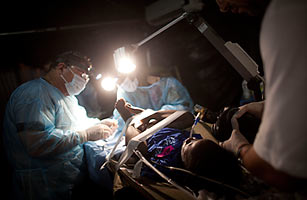
A Haitian is operated on at the Israeli army hospital in Port-au-Prince
Jean Marc Loremas, 46, carried his niece more than a mile from their home in the La Plaine area of Port-au-Prince to a sparsely populated industrial zone. There he nodded to two foreign guards in olive green fatigues and about a dozen semiambulatory earthquake victims who were already lined up on various pallets, crutches and canes before pounding on a metal sliding gate. "Shalom?" came the response as the eyehole shot back. Loremas explained his needs, and soon an Israeli doctor came out to examine the woman's broken femur.
Eight hours later, they were still there waiting for treatment, but Loremas knew that his 18-year-old niece Richline was one of the lucky ones. Like his little sister, whom he had deposited at the same field hospital the day before, she would be getting the best care possible in earthquake-ravaged Haiti. The Israeli hospital can treat only about 100 people a day, but it is the paramount medical center operating in Haiti in the aftermath of the Jan. 12 earthquake. It receives the cases that other hospitals find difficult and cannot manage. Upon entry, patients are photographed, and then they and their electronic records are digitally tracked around the tent complex with bar-coded bracelets. Ninety percent of those in Israeli hands have complex crushed limbs and bones — crush syndrome. But given the severity of the injuries and the conditions in apocalyptic Port-au-Prince, the hospital has had an amazing success rate: of the more than 400 people treated by Jan. 19, only eight had died.
Would that all of Haiti were so lucky. As efforts turn from rescue to recovery, the crisis' biggest focus is medical care: tens of thousands of people are still in need of attention, and broken bones are quickly becoming deadly as gangrene sets in. "We have 300 to 400 patients waiting to be seen, and if we can't get to them in the next 48 hours, half could die," says Eli Call, an American volunteer at the Adventist University Hospital, which has more than tripled its pre-earthquake capacity, treating more than 1,250 people since the disaster. Most of Haiti's hospitals were destroyed in the earthquake. To fill the void, the U.N. has so far brought in seven field hospitals, including the Israeli one, to augment the few Haitian facilities that are left standing. On Jan. 20, the U.S.N.S. Comfort arrived, though a strong aftershock that morning took out the pier where it was hoped it would dock.
Aside from the basic triage — the treatment of relatively simple ailments that might have become life-threatening if left unattended over the nine days since the quake — the biggest problem is dialysis. A symptom of crush syndrome is kidney failure. Both the Comfort and the Israeli hospital are converted war units where dialysis is not generally needed. Local hospitals are no longer equipped for it, and the few willing to try it — like Doctors Without Borders — have had logistical nightmares getting the proper equipment in. Almost any patient pulled from the rubble with severely crushed limbs who doesn't get treatment or an amputation quickly enough runs a high risk of dying of renal failure. An 8-year-old boy pulled miraculously from the rubble on Jan. 20 after being buried for eight days will surely be watched for any indication of the syndrome.